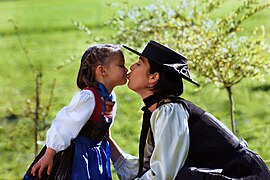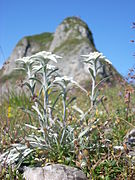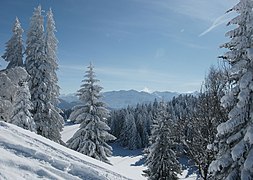Bregenz Forest: Difference between revisions
m link [wW]ood processing |
Added links and photo descriptions, minor changes to layout |
||
| Line 54: | Line 54: | ||
== Culture == |
== Culture == |
||
| ⚫ | |||
=== Dialect === |
=== Dialect === |
||
| ⚫ | Until 1814, parts of the [[Allgäu]] in the north and north-west belonged to Vorarlberg. Since the entire region was settled by the [[Alemanni]], the Lake Constance Alemannic dialect became predominant beginning in the 5th and 6th centuries. Over the centuries there was a brisk trading of goods which, with the increased extension of marriages and family networks, led to a linguistic intermingling. Especially in the "Vorderwald" the influence of the Allgäu dialect is particularly noticeable. By contrast, in the Mittelwald and Hinterwald regions the predominant language forms show a stronger connection with the [[Hofsteig]] region and Dornbirn. Speakers outside of the Bregenzer Wald region perceive (''Wälderisch'') as an idiom of its own. It must be noted, however, that there is no uniform [[Vorarlbergisch]] dialect; there are considerable local and regional variations. The official language in Vorarlberg is, of course, [[High German languages|High German]] (Hochdeutsch). |
||
| ⚫ | |||
| ⚫ | Until 1814, parts of the [[Allgäu]] in the north and north-west belonged to Vorarlberg. Since the entire region was settled by the [[Alemanni]], the Lake Constance Alemannic dialect became predominant beginning in the 5th and 6th centuries. Over the centuries there was a brisk trading of goods which, with the increased extension of marriages and family networks, led to a linguistic intermingling. Especially in the "Vorderwald" the influence of the Allgäu dialect is particularly noticeable. By contrast, in the Mittelwald and Hinterwald regions the predominant language forms show a stronger connection with the [[Hofsteig]] region and Dornbirn. Speakers outside of the Bregenzer Wald region perceive (''Wälderisch'') as an idiom of its own. It must be noted, however, that there is no uniform [[Vorarlbergisch]] dialect |
||
=== Tracht === |
=== Tracht === |
||
Traditional costumes ("[[Tracht]]") have a long history in Vorarlberg. Many valleys and villages have their own kind of garb, each with special characteristics from certain style periods. The Bregenzerwälder garb is the oldest of its kind. It originated in the 15/16th century. The Bregenzerwälder tracht for women is called " |
Traditional costumes ("[[Tracht]]") have a long history in Vorarlberg. Many valleys and villages have their own kind of garb, each with special characteristics from certain style periods. The Bregenzerwälder garb is the oldest of its kind. It originated in the 15/16th century. The Bregenzerwälder tracht for women is called "d'Juppô" ([[Bavarian language|Bavarian]]: "Juppe").<ref>{{Cite web|title=Vorarlberger Landestrachtenverband: Frauentracht|url=http://www.trachtenverband.at/trachten/bregenzerwald/frauentracht.html|access-date=2020-09-07|website=www.trachtenverband.at}}</ref><ref>{{Cite web|date=2014-09-09|title=Alles über die Bregenzerwälder Juppe|url=https://www.trachtenbibel.at/bregenzerwaelder-juppe/|access-date=2020-09-07|website=Trachtenbibel|language=de-DE}}</ref> |
||
One of the last places that still manufacture the Juppe in the traditional way is the [[Juppenwerkstatt Riefensberg]].<ref>{{Cite web|title=Juppenwerkstatt Riefensberg|url=https://www.bregenzerwald.at/en/activity/juppenwerkstatt-riefensberg-2/|access-date=2020-09-07|website=Bregenzerwald in Vorarlberg|language=en}}</ref> |
One of the last places that still manufacture the Juppe in the traditional way is the [[Juppenwerkstatt Riefensberg]].<ref>{{Cite web|title=Juppenwerkstatt Riefensberg|url=https://www.bregenzerwald.at/en/activity/juppenwerkstatt-riefensberg-2/|access-date=2020-09-07|website=Bregenzerwald in Vorarlberg|language=en}}</ref> |
||
| ⚫ | |||
=== Architecture === |
=== Architecture === |
||
| ⚫ | |||
The [[Bregenzerwälderhaus]] is a traditional agricultural housing type of the Bregenz Forest region. In the Bregenzerwälderhaus, the residential building, the stable and the barn are all located under one roof.<ref>{{Cite web |title=Mein Österreich – Das Bregenzerwaldhaus |url=https://www.mein-oesterreich.info/landschaften-orte/bregenzerwaldhaus.htm |access-date=2022-05-12 |website=www.mein-oesterreich.info}}</ref> |
|||
In 2014, the project [[BUS:STOP Krumbach]] was completed. When the municipality of [[Krumbach, Vorarlberg|Krumbach]] decided to rebuild seven bus stops in 2010, they hired seven international architects to design bus shelters. Local craftsmen executed their designs. While each stop differs in design, the bus stops are all meant to uniquely integrate architecture into the natural surroundings.<ref>{{Cite web|url=https://www.vorarlberg.travel/en/busstop-krumbach/|title=BUS:STOP Krumbach - Everyday Architecture|date=2017-08-11|website=Urlaub in Vorarlberg|language=en-US|access-date=2019-04-26}}</ref> |
In 2014, the project [[BUS:STOP Krumbach]] was completed. When the municipality of [[Krumbach, Vorarlberg|Krumbach]] decided to rebuild seven bus stops in 2010, they hired seven international architects to design bus shelters. Local craftsmen executed their designs. While each stop differs in design, the bus stops are all meant to uniquely integrate architecture into the natural surroundings.<ref>{{Cite web|url=https://www.vorarlberg.travel/en/busstop-krumbach/|title=BUS:STOP Krumbach - Everyday Architecture|date=2017-08-11|website=Urlaub in Vorarlberg|language=en-US|access-date=2019-04-26}}</ref> |
||
| Line 75: | Line 76: | ||
=== Tourism === |
=== Tourism === |
||
The Bregenz Forest is known also as a [[skiing]] region, but other attractions include the |
The Bregenz Forest is known also as a [[skiing]] region, but other attractions include the [[KäseStrasse Bregenzerwald|Käsestraße Bregenzerwald]] and the [[Schubertiade Vorarlberg|Schubertiade]] (festival of classical music), in [[Schwarzenberg, Austria|Schwarzenberg]]. The Bregenz Forest is cherished for its unspoiled nature, old traditions, and genuine hospitality. It is also particularly well-known amongst [[gourmet]]s for its "[[Käsestrasse Bregenzerwald|KäseStrasse Bregenzerwald]]",<ref>[http://www.kaesestrasse.at KäseStrasse Bregenzerwald (in German)]</ref> an association of farmers, restaurateurs, craftspeople and traders promoting the Bregenz Forest agriculture and its local products, especially cheese. In particular, Bregenz Forest Mountain Cheese ("[[Vorarlberger Bergkäse|Bregenzerwälder Bergkäse]]") and the [[Alpkäse]] are internationally renowned specialities. |
||
The [[Bregenz Forest Railway]] ("Bregenzerwaldbahn" or, colloquially, "’s Wälderbähnle") |
The [[Bregenz Forest Railway]] ("Bregenzerwaldbahn" or, colloquially, "’s Wälderbähnle") is a [[museum railway]] that operates on a surviving section of a [[narrow gauge railway]]. From 1902 to 1983, the so-called "Wälderbähnle" worked a line stretching 35.5 kilometres (22 mi) from [[Bregenz]] to [[Bezau]]. In October 2004, a section of 5 km (3.1 mi) was opened up for tourists again. |
||
| ⚫ | |||
==== Museums ==== |
|||
In 2000, the [[Hittisau Women's Museum|Women's Museum]] opened in [[Hittisau]], the only one of its kind in Austria.<ref>[http://www.frauenmuseum.at/ Frauenmuseum Hittisau] accessed on 6 September 2011</ref> The museum is devoted to the display and documentation of the cultural works and (her) stories of women, which deal with a broad variety of topics, including questions of female identity and gender roles.<ref>[http://www.frauenmuseum.at/?cat=4&page=24 Frauenmuseum Hittisau - Konzept (in German)]</ref> |
In 2000, the [[Hittisau Women's Museum|Women's Museum]] opened in [[Hittisau]], the only one of its kind in Austria.<ref>[http://www.frauenmuseum.at/ Frauenmuseum Hittisau] accessed on 6 September 2011</ref> The museum is devoted to the display and documentation of the cultural works and (her) stories of women, which deal with a broad variety of topics, including questions of female identity and gender roles.<ref>[http://www.frauenmuseum.at/?cat=4&page=24 Frauenmuseum Hittisau - Konzept (in German)]</ref> |
||
Another cultural attraction in the Bregenz Forest is the [[Angelika Kauffmann Museum]]<ref>[http://www.angelika-kauffmann.com/ Angelika Kauffmann Museum] {{Webarchive|url=https://web.archive.org/web/20181104234639/http://www.angelika-kauffmann.com/ |date=2018-11-04 }} accessed on 6 September 2011</ref> in [[Schwarzenberg (Vorarlberg)|Schwarzenberg]]. The museum is dedicated to the Classicist artist [[Angelica Kauffman]], and has an Austrian museum seal of quality. |
Another cultural attraction in the Bregenz Forest is the [[Angelika Kauffmann Museum]]<ref>[http://www.angelika-kauffmann.com/ Angelika Kauffmann Museum] {{Webarchive|url=https://web.archive.org/web/20181104234639/http://www.angelika-kauffmann.com/ |date=2018-11-04 }} accessed on 6 September 2011</ref> in [[Schwarzenberg (Vorarlberg)|Schwarzenberg]]. The museum is dedicated to the Classicist artist [[Angelica Kauffman]], and has an Austrian museum seal of quality. |
||
| ⚫ | |||
== Gallery == |
== Gallery == |
||
<gallery mode="nolines" widths="200"> |
<gallery mode="nolines" widths="200"> |
||
File:Stöggele310Diedamskopf.JPG|A [[Bregenzerwälderhaus]] on the Diedamskopf mountain |
|||
| ⚫ | |||
File:Juppentracht 08a.JPG|Mother and daughter in Bregenz Forest costume |
File:Juppentracht 08a.JPG|Mother and daughter in Bregenz Forest costume |
||
File:KäsekellerLingenau1.JPG|Cheese cellar in [[Lingenau]] in the Bregenz Forest |
File:KäsekellerLingenau1.JPG|Cheese cellar in [[Lingenau]] in the Bregenz Forest |
||
File:Edelweiss auf der Kanisfluh Hanno Thurnher Cinedoku Vorarlberg.JPG|[[Edelweiss]] |
File:Edelweiss auf der Kanisfluh Hanno Thurnher Cinedoku Vorarlberg.JPG|[[Leontopodium nivale|Edelweiss]] flower on the [[Kanisfluh]] |
||
File:Brüggelekopf Juppenspitze.JPG|Spruce forest on the Brüggelekopf in [[Alberschwende]]. Between the trees, there are the Juppenspitze and the Mohnenfluh in [[Schröcken]] on the left and the northern flank of the [[Kanisfluh]] on the right. |
|||
File:Brüggelekopf Juppenspitze.JPG|Snow |
|||
File:Bödele Bregenzerwald Panorama.jpg| |
File:Bödele Bregenzerwald Panorama.jpg|180° panorama on the Bödele, located between [[Dornbirn]] and [[Schwarzenberg, Austria|Schwarzenberg]] |
||
File:DamülserStrasseAlt.JPG |
File:DamülserStrasseAlt.JPG|Bridge over the Mitteltobelbach of the old Faschina Straße (L193) from [[Au, Vorarlberg|Au]] to [[Damüls]] |
||
File:Bregenzerwaldgebirge Panorama.jpg|Mountain panorama with the dominant [[Kanisfluh]] in the centre |
File:Bregenzerwaldgebirge Panorama.jpg|Mountain panorama with the dominant [[Kanisfluh]] in the centre |
||
File:Werkraum Haus von Peter Zumthor in Andelsbuch 1.JPG|[[Werkraum Bregenzerwald]]: The "Werkraum Haus" was designed by [[Peter Zumthor]] and opened in 2012. |
File:Werkraum Haus von Peter Zumthor in Andelsbuch 1.JPG|[[Werkraum Bregenzerwald]]: The "Werkraum Haus" was designed by [[Peter Zumthor]] and opened in 2012. |
||
| ⚫ | |||
</gallery> |
</gallery> |
||
Revision as of 12:22, 12 May 2022
| Bregenz Forest | |
|---|---|
| Bregenzerwald | |
 Damülser Mittagspitze, 2,095m | |
| Highest point | |
| Peak | Glatthorn |
| Elevation | 2,134 m (7,001 ft) |
| Coordinates | 47°15′56″N 9°52′48″E / 47.26556°N 9.88000°E |
| Geography | |
| Country | Austria |
| States | Vorarlberg |
| Parent range | Northern Limestone Alps |
The Bregenz Forest (German: Bregenzerwald, pronounced [ˈbʁeːɡɛnt͡sɐˌvalt] ) is one of the main regions in the state of Vorarlberg (Austria). It overlaps, but is not coterminous with, the Bregenz Forest Mountains, which belong to a range of the Northern Limestone Alps, specifically the northern flysch zone. It is the drainage basin of the Bregenzer Ach river.
Geography
The regional inhabitants often divide the Bregenz Forest into two main areas, the Vorderwald ("anterior forest") and Hinterwald ("hinterforest"). The Vorderwald, with its hills and low mountains, is closest to the Rhine valley. The Hinterwald has the higher mountains, with altitudes of up to 2,000 metres. Each of the two regions has its own distinctive dialect variations.
Villages

The principal villages in the Bregenz Forest are Bezau (the local capital), Alberschwende, and Egg. Alberschwende, as a historic "Hofsteig" municipality was formerly not part of the Bregenz Forest region.
Lower Bregenz Forest (Vorderer Bregenzerwald) (red)
Upper Bregenz Forest (Hinterer Bregenzerwald) (blue)
- Egg
- Andelsbuch
- Schwarzenberg
- Bezau
- Reuthe
- Bizau
- Mellau
- Schnepfau
- Au
- Damüls
- Schoppernau
- Schröcken
- Warth
Culture

Dialect
Until 1814, parts of the Allgäu in the north and north-west belonged to Vorarlberg. Since the entire region was settled by the Alemanni, the Lake Constance Alemannic dialect became predominant beginning in the 5th and 6th centuries. Over the centuries there was a brisk trading of goods which, with the increased extension of marriages and family networks, led to a linguistic intermingling. Especially in the "Vorderwald" the influence of the Allgäu dialect is particularly noticeable. By contrast, in the Mittelwald and Hinterwald regions the predominant language forms show a stronger connection with the Hofsteig region and Dornbirn. Speakers outside of the Bregenzer Wald region perceive (Wälderisch) as an idiom of its own. It must be noted, however, that there is no uniform Vorarlbergisch dialect; there are considerable local and regional variations. The official language in Vorarlberg is, of course, High German (Hochdeutsch).
Tracht
Traditional costumes ("Tracht") have a long history in Vorarlberg. Many valleys and villages have their own kind of garb, each with special characteristics from certain style periods. The Bregenzerwälder garb is the oldest of its kind. It originated in the 15/16th century. The Bregenzerwälder tracht for women is called "d'Juppô" (Bavarian: "Juppe").[1][2] One of the last places that still manufacture the Juppe in the traditional way is the Juppenwerkstatt Riefensberg.[3]
Architecture

The Bregenzerwälderhaus is a traditional agricultural housing type of the Bregenz Forest region. In the Bregenzerwälderhaus, the residential building, the stable and the barn are all located under one roof.[4]
In 2014, the project BUS:STOP Krumbach was completed. When the municipality of Krumbach decided to rebuild seven bus stops in 2010, they hired seven international architects to design bus shelters. Local craftsmen executed their designs. While each stop differs in design, the bus stops are all meant to uniquely integrate architecture into the natural surroundings.[5]
The Werkraum Bregenzerwald is an association of craftsmen in the Bregenz Forest founded in 1999. It aims at networking and supporting craft, design and technology businesses in the area. The publicly accessible place is used to present the craftsmanship, to promote building culture in cooperation with architects and to increase design competence and quality of craftsmanship with the preferred involvement of young people.[6]
Economy

Residents of the Bregenz Forest earn their living primarily from tourism, agriculture and especially the wood processing industry. Many locals also commute to work in the Rhine Valley, Vorarlberg's economic center.
Alpine transhumance denotes the three-tier agricultural structure of the Bregenz Forest. It is the seasonal movement of livestock between mountain and lowland pastures, usually under the care of herders. In spring 2011, it was declared as intangible cultural heritage by UNESCO. It was recognised that the Bregenz Forest is "an impressive landscape on the north side of the Alps" that has "largely maintained its traditional farming structure." This includes linear or nucleated villages, with farmsteads dating back to the 18th and 19th centuries. In addition, there are many small craft workshops within the farming communities. Singled out for particular mention were the villages of Thal, Schwarzenberg, and Schoppernau, with their outstanding examples of original Bregenz Forest houses ("Wälderhäuser").[7]
Tourism
The Bregenz Forest is known also as a skiing region, but other attractions include the Käsestraße Bregenzerwald and the Schubertiade (festival of classical music), in Schwarzenberg. The Bregenz Forest is cherished for its unspoiled nature, old traditions, and genuine hospitality. It is also particularly well-known amongst gourmets for its "KäseStrasse Bregenzerwald",[8] an association of farmers, restaurateurs, craftspeople and traders promoting the Bregenz Forest agriculture and its local products, especially cheese. In particular, Bregenz Forest Mountain Cheese ("Bregenzerwälder Bergkäse") and the Alpkäse are internationally renowned specialities.
The Bregenz Forest Railway ("Bregenzerwaldbahn" or, colloquially, "’s Wälderbähnle") is a museum railway that operates on a surviving section of a narrow gauge railway. From 1902 to 1983, the so-called "Wälderbähnle" worked a line stretching 35.5 kilometres (22 mi) from Bregenz to Bezau. In October 2004, a section of 5 km (3.1 mi) was opened up for tourists again.
The region is also popular because of its hiking and cycling trails.
Museums
In 2000, the Women's Museum opened in Hittisau, the only one of its kind in Austria.[9] The museum is devoted to the display and documentation of the cultural works and (her) stories of women, which deal with a broad variety of topics, including questions of female identity and gender roles.[10]
Another cultural attraction in the Bregenz Forest is the Angelika Kauffmann Museum[11] in Schwarzenberg. The museum is dedicated to the Classicist artist Angelica Kauffman, and has an Austrian museum seal of quality.
Gallery
-
A Bregenzerwälderhaus on the Diedamskopf mountain
-
Mother and daughter in Bregenz Forest costume
-
Cheese cellar in Lingenau in the Bregenz Forest
-
Spruce forest on the Brüggelekopf in Alberschwende. Between the trees, there are the Juppenspitze and the Mohnenfluh in Schröcken on the left and the northern flank of the Kanisfluh on the right.
-
180° panorama on the Bödele, located between Dornbirn and Schwarzenberg
-
Mountain panorama with the dominant Kanisfluh in the centre
-
Werkraum Bregenzerwald: The "Werkraum Haus" was designed by Peter Zumthor and opened in 2012.
-
BUS:STOP no. 2 by Spanish architect Antón García-Abril
References
- ^ "Vorarlberger Landestrachtenverband: Frauentracht". www.trachtenverband.at. Retrieved 2020-09-07.
- ^ "Alles über die Bregenzerwälder Juppe". Trachtenbibel (in German). 2014-09-09. Retrieved 2020-09-07.
- ^ "Juppenwerkstatt Riefensberg". Bregenzerwald in Vorarlberg. Retrieved 2020-09-07.
- ^ "Mein Österreich – Das Bregenzerwaldhaus". www.mein-oesterreich.info. Retrieved 2022-05-12.
- ^ "BUS:STOP Krumbach - Everyday Architecture". Urlaub in Vorarlberg. 2017-08-11. Retrieved 2019-04-26.
- ^ "Werkraum Bregenzerwald – Werkraum" (in German). Retrieved 2021-03-08.
- ^ "Bregenzerwald (Bregenz Forest)" at whc.unesco.org. Accessed on 13 Mar 2013.
- ^ KäseStrasse Bregenzerwald (in German)
- ^ Frauenmuseum Hittisau accessed on 6 September 2011
- ^ Frauenmuseum Hittisau - Konzept (in German)
- ^ Angelika Kauffmann Museum Archived 2018-11-04 at the Wayback Machine accessed on 6 September 2011
External links
- Official website(in English)










